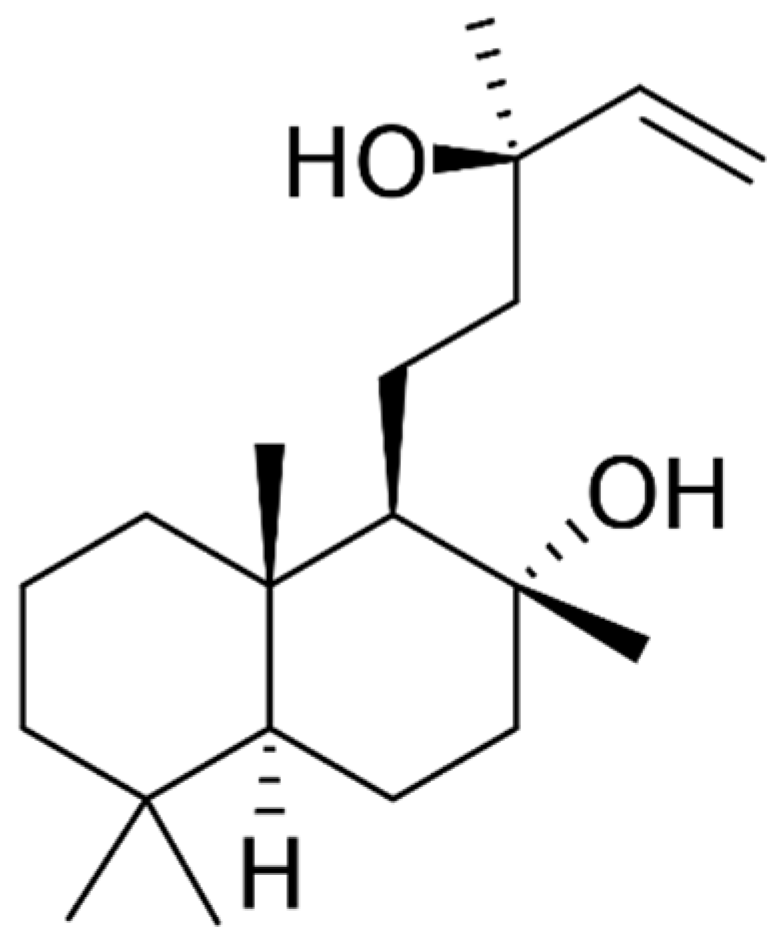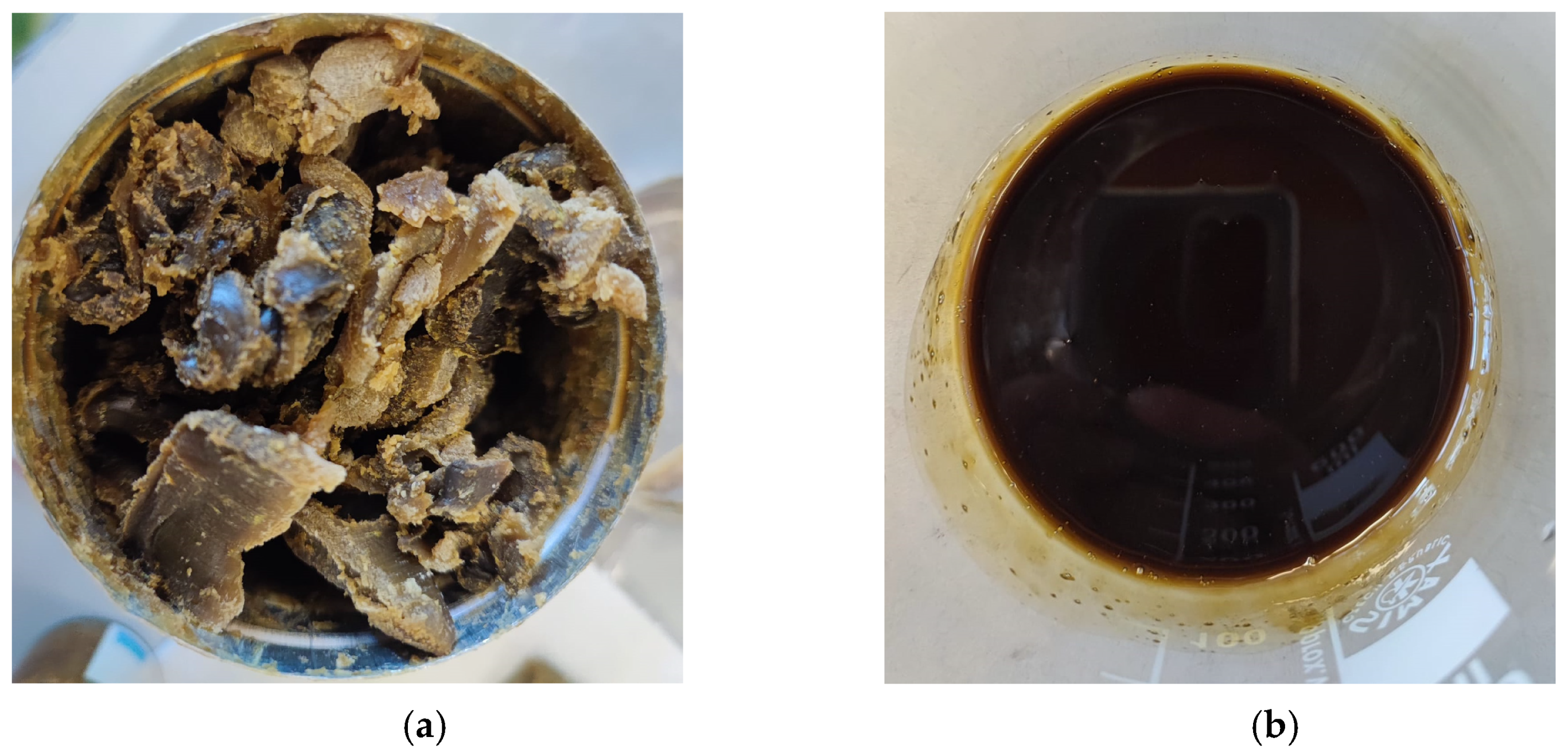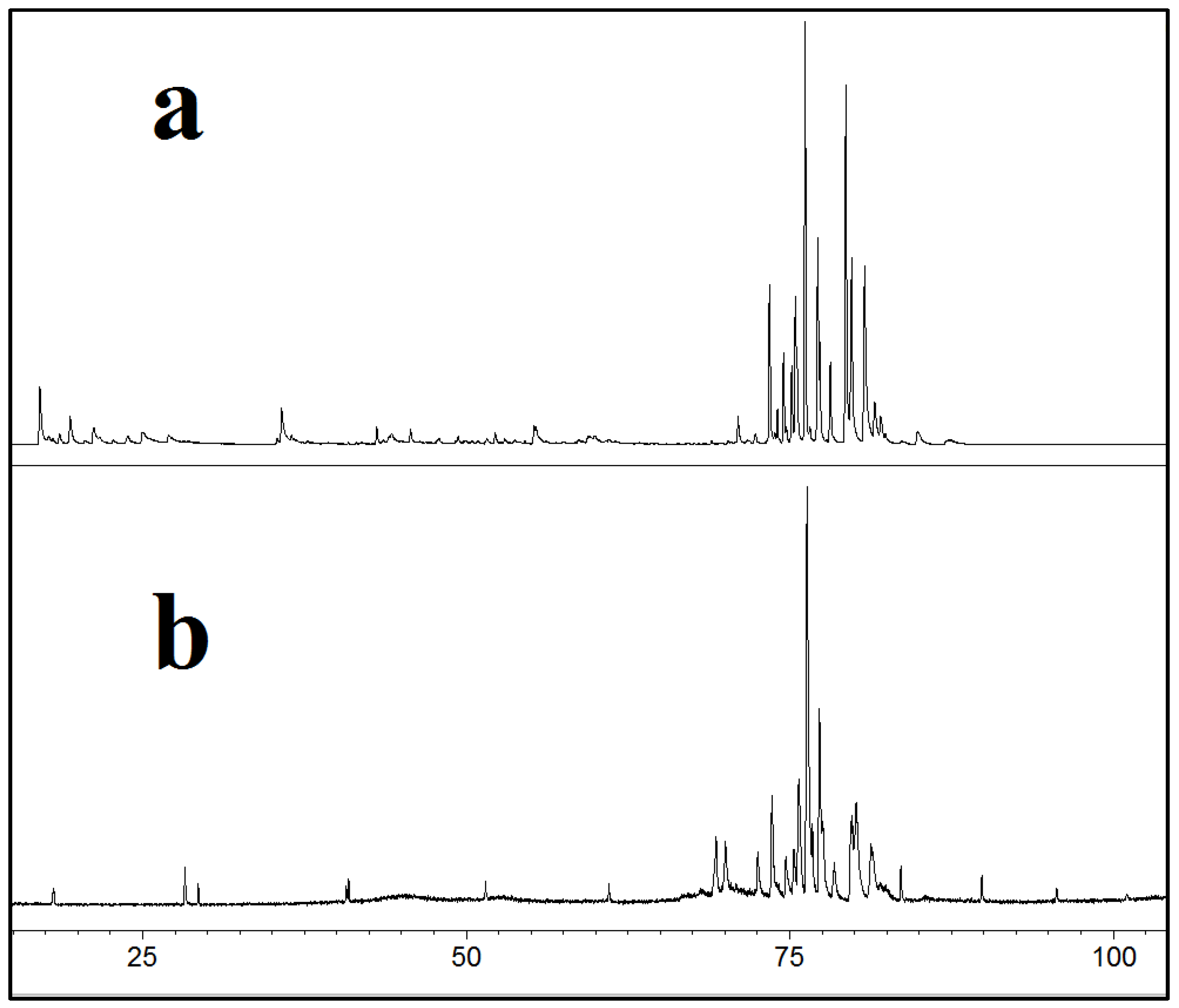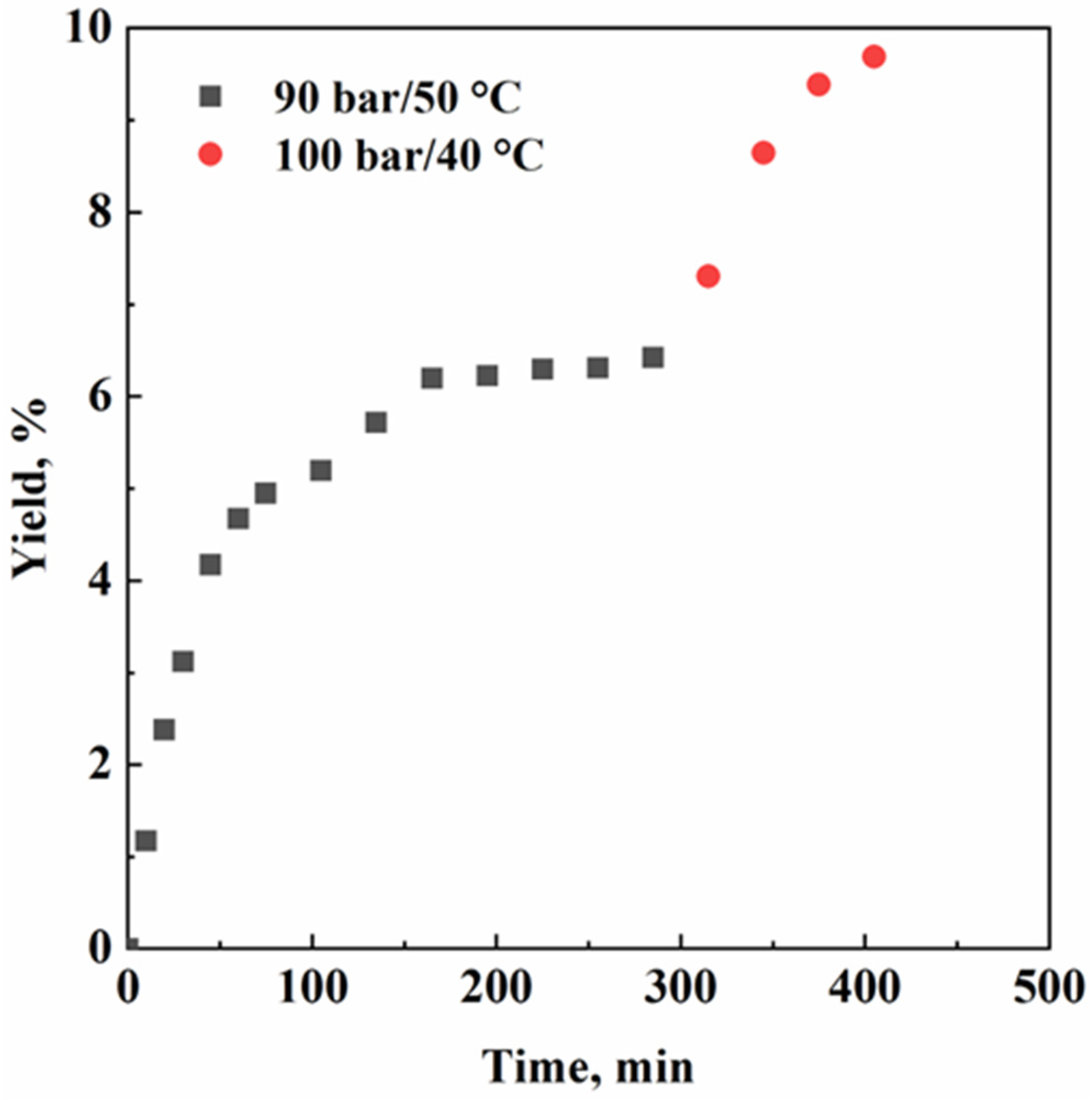Supercritical Fluid Extraction of Essential Oil and Sclareol from a Clary Sage Concrete
Abstract
1. Introduction
2. Results and Discussion
3. Materials and Methods
3.1. Materials and Chemicals
3.2. Supercritical Fluid Extraction
3.3. GC-MS Analysis
4. Conclusions
Author Contributions
Funding
Acknowledgments
Conflicts of Interest
Sample Availability Statement
References
- Elnir, O.; Putievsky, E.; Ravid, U.; Dudai, N.; Ladizinsky, G. Genetic affinity between two chemotypes of clary sage (Salvia sclarea L.). Euphytica 1991, 54, 205–208. [Google Scholar] [CrossRef]
- Durling, N.E.; Catchpole, O.J.; Grey, J.B.; Webby, R.F.; Mitchell, K.A.; Yeap Foo, L.; Perry, N.B. Extraction of phenolics and essential oil from dried sage (Salvia officinalis) using ethanol-water mixtures. Food Chem. 2007, 101, 1417–1424. [Google Scholar] [CrossRef]
- Sharifi-Rad, M.; Ozcelik, B.; Altin, G.; Daşkaya-Dikmen, C.; Martorell, M.; Ramírez-Alarcón, K.; Alarcón-Zapata, P.; Morais-Braga, M.F.B.; Carneiro, J.N.P.; Leal, A.L.A.B.; et al. Salvia spp. plants-from farm to food applications and phytopharmacotherapy. Trends Food Sci. Technol. 2018, 80, 242–263. [Google Scholar] [CrossRef]
- Mot, M.-D.; Gavrilaş, S.; Lupitu, A.I.; Moisa, C.; Chambre, D.; Tit, D.M.; Bogdan, M.A.; Bodescu, A.-M.; Copolovici, L.; Copolovici, D.M.; et al. Salvia officinalis L. Essential Oil: Characterization, antioxidant properties, and the effects of aromatherapy in adult patients. Antioxidants 2022, 11, 808. [Google Scholar] [CrossRef] [PubMed]
- Heydarpour, S.; Sharifipour, F.; Salari, N. Effect of aromatherapy using Salvia officinalis on sleep quality of postmenopausal women. Iran. J. Obstet. Gynecol. Infertil. 2020, 23, 50–57. [Google Scholar] [CrossRef]
- Karataş, H.; Ertekin, S. Antimicrobial activities of the essential oils of for Salvia species from Turkey. J. Med. Plants Res. 2010, 4, 1238–1240. [Google Scholar]
- Cui, H.; Zhang, X.; Zhou, H.; Zhao, C.; Lin, L. Antimicrobial activity and mechanisms of Salvia sclarea essential oil. Bot. Stud. 2015, 56, 1–8. [Google Scholar] [CrossRef]
- Sienkiewicz, M.; Głowacka, A.; Poznańska-Kurowska, K.; Kaszuba, A.; Urbaniak, A.; Kowalczyk, E. The effect of clary sage oil on staphylococci responsible for wound infections. Postep. Alergol. 2015, 32, 21–26. [Google Scholar] [CrossRef]
- Raveau, R.; Fontaine, J.; Verdin, A.; Mistrulli, L.; Laurelle, F.; Fourmentin, S.; Lounès-Hadj Sahraoui, A. Chemical composition, antioxidant and anti-inflammatory activities of clary sage and coriander essential oils produced on polluted and amended soils-phytomanagement approach. Molecules 2021, 26, 5321. [Google Scholar] [CrossRef]
- Hans, M.; Deeksha; Nayik, G.A.; Salaria, A. Clary sage essential oil. In Essential Oils; Nayik, G.A., Ansari, M.J., Eds.; Academic Press: New York, NY, USA, 2023; pp. 459–478. [Google Scholar] [CrossRef]
- Jassbi, A.R.; Zare, S.; Firuzi, O.; Xiao, J. Bioactive phytochemicals from shoots and roots of Salvia species. Phytochem. Rev. 2016, 15, 829–867. [Google Scholar] [CrossRef]
- Schmiderer, C.; Grassi, P.; Novak, J.; Weber, M.; Franz, C. Diversity of essential oil glands of clary sage (Salvia sclarea L., Lamiaceae). Plant Biol. 2008, 10, 433–440. [Google Scholar] [CrossRef] [PubMed]
- Baydar, H.; Kemal Sangun, M. Comparison of aroma compounds in distilled and extracted products of sage (salvia officinalis L.). J. Essent. Oil-Bear. Plants 2011, 16, 39–44. [Google Scholar] [CrossRef]
- Seo, S.; Gomi, K.; Kaku, H.; Abe, H.; Seto, H.; Nakatsu, S.; Neya, M.; Kobayashi, M.; Nakaho, K.; Ichinose, Y.; et al. Identification of natural diterpenes that inhibit baterial wilt disease in tobacco, tomato and arabidopsis. Plant Cell Physiol. 2012, 53, 1432–1444. [Google Scholar] [CrossRef]
- Zhou, J.; Xie, X.; Tang, H.; Peng, C.; Peng, F. The bioactivities of sclareol: A mini review. Front. Pharmacol. 2022, 13, 1014105. [Google Scholar] [CrossRef]
- Ribeiro Campos, D.; Celotto, A.C.; Albuquerque, A.A.S.; Garros Ferreira, L.; Santana e Neves Monteiro, A.; Barbosa Coelho, E.; Barbosa Evora, P.R. The diterpene sclareol vascular effect in normotensive and hypertensive rats. Arq. Bras. Cardiol. 2017, 109, 117–123. [Google Scholar] [CrossRef]
- Han, X.; Zhang, J.; Zhou, L.; Wei, J.; Tu, Y.; Shi, Q.; Zhang, Y.; Ren, J.; Wang, Y.; Ying, H.; et al. Sclareol ameliorates hyperglycemia-induced renal injury through inhibiting the MAPK/NF-κB signaling pathway. Phytother. Res. 2022, 36, 2511–2523. [Google Scholar] [CrossRef] [PubMed]
- Nait Amar, M.; Jahanban Chahfarokhi, A.; Zaraibi, N. Predicting thermal conductivity of carbon dioxide using group of data-driven models. J. Taiwan Inst. Chem. Eng. 2022, 132, 104210. [Google Scholar] [CrossRef]
- Sarkar, S.; Gayen, K.; Bhowmick, T.K. Green extraction of biomolecules from algae using subcritical and supercritical fluids. Biomass Convers. Biorefin. 2022. [Google Scholar] [CrossRef]
- López-Hortas, L.; Rodríguez, P.; Díaz-Reinoso, B.; Gaspar, M.C.; de Sousa, H.C.; Braga, M.E.M.; Domínguez, H. Supercritical fluid extraction as a suitable technology to recover bioactive compounds from flowers. J. Supercrit. Fluids 2022, 188, 105652. [Google Scholar] [CrossRef]
- Ronyai, E.; Simandi, B.; Lemberkovics, E.; Veress, T.; Patiaka, D. Comparison of the volatile composition of clary sage oil obtained by hydrodistillation and supercritical fluid extraction. J. Essent. Oil Res. 1999, 11, 69–71. [Google Scholar] [CrossRef]
- Aleksovski, S.A.; Sovová, H. Supercritical CO2 extraction of Salvia officinalis L. J. Supercrit. Fluids 2007, 40, 239–245. [Google Scholar] [CrossRef]
- Sovova, H.; Stateva, R.P. New approach to modeling supercritical CO2 extraction of cuticular waxes: Interplay between solubility and kinetics. Ind. Eng. Chem. Res. 2015, 54, 4861–4870. [Google Scholar] [CrossRef]
- Zanotti, A.; Baldino, L.; Scognamiglio, M.; Reverchon, E. Post-processing of a lavender flowers solvent extract using supercritical CO2 fractionation. J. Taiwan Inst. Chem. Eng. 2023, 147, 104901. [Google Scholar] [CrossRef]
- Reverchon, E.; Della Porta, G.; Gorgoglione, D. Supercritical CO2 Fractionation of jasmine concrete. J. Supercrit. Fluids 1995, 1, 60–65. [Google Scholar] [CrossRef]
- Reverchon, E.; Della Porta, G. Tuberose concrete fractionation by supercritical carbon dioxide. J. Agric. Food Chem. 1997, 45, 1356–1360. [Google Scholar] [CrossRef]
- Reverchon, E.; Della Porta, G. Rose concrete fractionation by supercritical CO2. J. Supercrit. Fluids 1996, 9, 199–204. [Google Scholar] [CrossRef]
- Gupta, R.B.; Shim, J.-J. Solubility in Supercritical Carbon Dioxide, 1st ed.; CRC Press: Boca Raton, FL, USA, 2006. [Google Scholar] [CrossRef]
- Zeisler-Diehl, V.V.; Barthlott, W.; Schreiber, L. Plant cuticular waxes: Composition, function and interactions with microorganisms. In Hydrocarbons, Oils and Lipids: Diversity, Origin, Chemistry and Fate. Handbook of Hydrocarbon and Lipid Microbiology, 1st ed.; Wilkes, H., Ed.; Springer: Cham, Switzerland, 2020; pp. 123–138. [Google Scholar] [CrossRef]
- Reverchon, E.; Donsì, G.; Sesti Osséo, L. Modeling of supercritical fluid extraction from herbaceous matrices. Ind. Eng. Chem. Res. 1993, 32, 2721–2726. [Google Scholar] [CrossRef]
Disclaimer/Publisher’s Note: The statements, opinions and data contained in all publications are solely those of the individual authors and contributors and not of MDPI and/or the editor(s). MDPI and/or the editor(s) disclaim responsibility for any injury to people or property resulting from any ideas, methods, instructions or products referred to in the content. |





| Retention Time, min | Compound | 90 bar/50 °C | 100 bar/40 °C |
|---|---|---|---|
| 16.9 | Myrcene | 21.1 | 2.5 |
| 18.5 | α-terpinene | 3 | - |
| 19.3 | Limonene | 8.8 | 1.6 |
| 20.3 | β-ocimene, cis | 1.9 | - |
| 21.0 | β-ocimene, trans | 14.1 | - |
| 23.7 | Terpinolene | 3.8 | - |
| 24.8 | Linalool | 9.1 | - |
| 26.9 | α-terpineol | 10.1 | - |
| 35.7 | Linalyl acetate | 13.4 | 2.5 |
| 43.1 | α-copaene | 4.3 | - |
| 45.7 | Caryophyllene | 3.2 | - |
| 74.4 | Isoabienol | - | 9.7 |
| 76.2 | Sclareol | - | 25.3 |
| 79.3 | Manool | - | 15.9 |
| 80.8 | Thunbergol | - | 14.1 |
| 85.2 | Longifolene | - | 3.9 |
| Retention Time, min | Compound | Area (%) |
|---|---|---|
| 98.2 | Eicosane | 3.3 |
| 105.3 | Tricosane | 12.0 |
| 108.0 | Pentacosane | 7.5 |
| 109.2 | Hexacosanol | 5.4 |
| 111.0 | Heptacosane | 7.9 |
| 119.6 | Nonacosane | 4.6 |
Disclaimer/Publisher’s Note: The statements, opinions and data contained in all publications are solely those of the individual author(s) and contributor(s) and not of MDPI and/or the editor(s). MDPI and/or the editor(s) disclaim responsibility for any injury to people or property resulting from any ideas, methods, instructions or products referred to in the content. |
© 2023 by the authors. Licensee MDPI, Basel, Switzerland. This article is an open access article distributed under the terms and conditions of the Creative Commons Attribution (CC BY) license (https://creativecommons.org/licenses/by/4.0/).
Share and Cite
Zanotti, A.; Baldino, L.; Scognamiglio, M.; Reverchon, E. Supercritical Fluid Extraction of Essential Oil and Sclareol from a Clary Sage Concrete. Molecules 2023, 28, 3903. https://doi.org/10.3390/molecules28093903
Zanotti A, Baldino L, Scognamiglio M, Reverchon E. Supercritical Fluid Extraction of Essential Oil and Sclareol from a Clary Sage Concrete. Molecules. 2023; 28(9):3903. https://doi.org/10.3390/molecules28093903
Chicago/Turabian StyleZanotti, Alessandra, Lucia Baldino, Mariarosa Scognamiglio, and Ernesto Reverchon. 2023. "Supercritical Fluid Extraction of Essential Oil and Sclareol from a Clary Sage Concrete" Molecules 28, no. 9: 3903. https://doi.org/10.3390/molecules28093903
APA StyleZanotti, A., Baldino, L., Scognamiglio, M., & Reverchon, E. (2023). Supercritical Fluid Extraction of Essential Oil and Sclareol from a Clary Sage Concrete. Molecules, 28(9), 3903. https://doi.org/10.3390/molecules28093903









